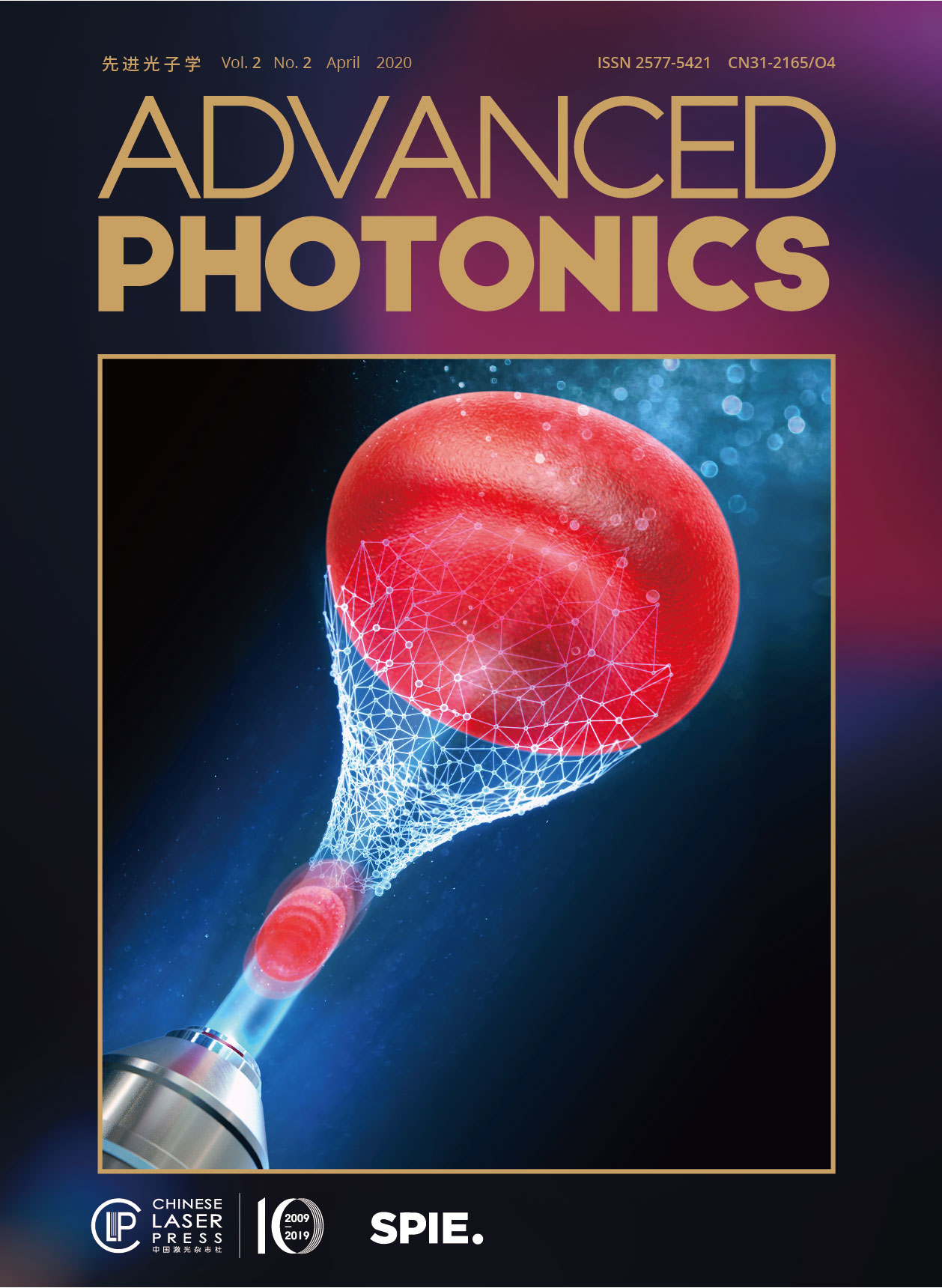 View fulltext
View fulltext
The image on the cover for Advanced Photonics Volume 2, Issue 2, demonstrates the three dimensional tomographic reconstruction of red blood cell using a deep neural network, which instantly provides high-fidelity reconstructions by solving the missing cone problem. The image is based on the research presented in the article, “Three-dimensional tomography of red blood cells using deep learning,” Adv. Phot. 2(2), 014003, doi: https://doi.org/10.1117/1.AP.2.2.026001.
A commentary on the article “Three-dimensional tomography of red blood cells using deep learning” by J. Lim, A. Ayoub, and D. Psaltis, Adv. Photonics Volume 2, Issue 2, doi: 10.1117/1.AP.2.2.026001.
Rogue waves (RWs) are rare, extreme amplitude, localized wave packets, which have received much interest recently in different areas of physics. Fiber lasers with their abundant nonlinear dynamics provide an ideal platform to observe optical RW formation. We review recent research progress on rogue waves in fiber lasers. Basic concepts of RWs and the mechanisms of RW generation in fiber lasers are discussed, along with representative experimental and theoretical results. The measurement methods for RW identification in fiber lasers are presented and analyzed. Finally, prospects for future RW research in fiber lasers are summarized.
Molecular alignment and orientation by laser fields has attracted significant attention in recent years, mostly due to new capabilities to manipulate the molecular spatial arrangement. Molecules can now be efficiently prepared for ionization, structural imaging, orbital tomography, and more, enabling, for example, shooting of dynamic molecular movies. Furthermore, molecular alignment and orientation processes give rise to fundamental quantum and classical phenomena like quantum revivals, Anderson localization, and rotational echoes, just to mention a few. We review recent progress on the visualization, coherent control, and applications of the rich dynamics of molecular rotational wave packets driven by laser pulses of various intensities, durations, and polarizations. In particular, we focus on the molecular unidirectional rotation and its visualization, the orientation of chiral molecules, and the three-dimensional orientation of asymmetric-top molecules. Rotational echoes are discussed as an example of nontrivial dynamics and detection of prepared molecular states.
We accurately reconstruct three-dimensional (3-D) refractive index (RI) distributions from highly ill-posed two-dimensional (2-D) measurements using a deep neural network (DNN). Strong distortions are introduced on reconstructions obtained by the Wolf transform inversion method due to the ill-posed measurements acquired from the limited numerical apertures (NAs) of the optical system. Despite the recent success of DNNs in solving ill-posed inverse problems, the application to 3-D optical imaging is particularly challenging due to the lack of the ground truth. We overcome this limitation by generating digital phantoms that serve as samples for the discrete dipole approximation (DDA) to generate multiple 2-D projection maps for a limited range of illumination angles. The presented samples are red blood cells (RBCs), which are highly affected by the ill-posed problems due to their morphology. The trained network using synthetic measurements from the digital phantoms successfully eliminates the introduced distortions. Most importantly, we obtain high fidelity reconstructions from experimentally recorded projections of real RBC sample using the network that was trained on digitally generated RBC phantoms. Finally, we confirm the reconstruction accuracy using the DDA to calculate the 2-D projections of the 3-D reconstructions and compare them to the experimentally recorded projections.
Ultrafast lasers generating high-repetition-rate ultrashort pulses through various mode-locking methods can benefit many important applications, including communications, materials processing, astronomical observation, etc. For decades, mode-locking based on dissipative four-wave-mixing (DFWM) has been fundamental in producing pulses with repetition rates on the order of gigahertz (GHz), where multiwavelength comb filters and long nonlinear components are elemental. Recently, this method has been improved using filter-driven DFWM, which exploits both the filtering and nonlinear features of silica microring resonators. However, the fabrication complexity and coupling loss between waveguides and fibers are problematic. We demonstrate a tens- to hundreds- of gigahertz-stable pulsed all-fiber laser based on a hybrid plasmonic microfiber knot resonator device. Unlike previously reported pulse generation mechanisms, the operation utilizes the nonlinear-polarization-rotation (NPR) effect introduced by the polarization-dependent feature of the device to increase intracavity power for boosting DFWM mode-locking, which we term NPR-stimulated DFWM. The easily fabricated versatile device acts as a polarizer, comb filter, and nonlinear component simultaneously, thereby introducing an application of microfiber resonator devices in ultrafast and nonlinear photonics. We believe that our work underpins a significant improvement in achieving practical low-cost ultrafast light sources.
A key concept underlying the specific functionalities of metasurfaces is the use of constituent components to shape the wavefront of the light on demand. Metasurfaces are versatile, novel platforms for manipulating the scattering, color, phase, or intensity of light. Currently, one of the typical approaches for designing a metasurface is to optimize one or two variables among a vast number of fixed parameters, such as various materials’ properties and coupling effects, as well as the geometrical parameters. Ideally, this would require multidimensional space optimization through direct numerical simulations. Recently, an alternative, popular approach allows for reducing the computational cost significantly based on a deep-learning-assisted method. We utilize a deep-learning approach for obtaining high-quality factor (high-Q) resonances with desired characteristics, such as linewidth, amplitude, and spectral position. We exploit such high-Q resonances for enhanced light–matter interaction in nonlinear optical metasurfaces and optomechanical vibrations, simultaneously. We demonstrate that optimized metasurfaces achieve up to 400-fold enhancement of the third-harmonic generation; at the same time, they also contribute to 100-fold enhancement of the amplitude of optomechanical vibrations. This approach can be further used to realize structures with unconventional scattering responses.














